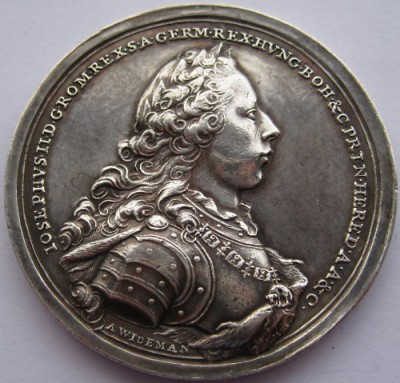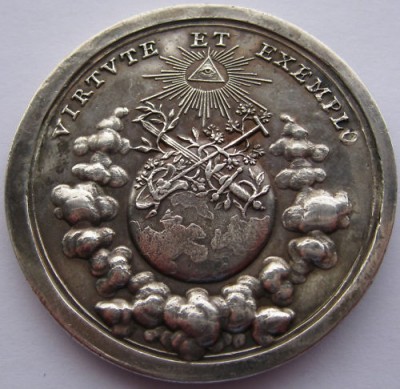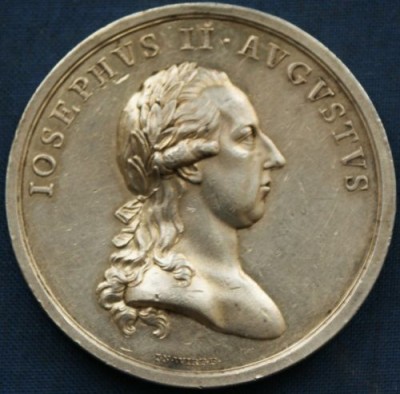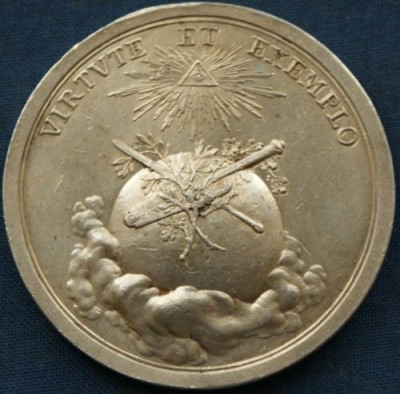Medal of Honour and Merit
With the accession of Joseph II to the throne of the King of Rome in 1764, the history of Austrian decorations begins to be written, with validity for the entire monarchy 1)
This medal is of a general military nature, but at the same time civilian persons were also decorated with them for merit. The medal was circular in shape with a fixed hanging loop and was worn on a chest-looped, threaded ribbon of crimson red ribbon, 39-40 mm wide.
The medals were struck as gold, large and small silver, and bronze. With the exception of the small bronze medal, which was 46 mm in diameter, all the medals were 50 mm in diameter.
Description of the medal
Obverse:
The obverse of the medal depicts a portrait of Joseph II wearing an ornate cuirass and cloak with the Order of the Golden Fleece on his breast, stroking his left arm, with a laurel wreath in loose hair flowing down his back. The name of the medallist and engraver A.WIDEMANN appears in the portrait's incised border
Around the portrait, along the edge of the medal, a Latin inscription:
IOSEPHVS II.D.G.ROM.REX S.A.GERM.REX HVNG.BOH.& C.PRIN.HERED.A.A. & C.
(Joseph II. by the grace of God, King of Rome, ever multiplier of empire, King of Hungary, Bohemia, co-ruler and hereditary Crown Prince, Archduke of Austria, etc., etc.)1)
Reverse:
On the reverse of the medal there is a globe surrounded by clouds in the middle over which the eye of God watches. At the top of the globe are a crossed sword and spade intertwined with oak and laurel branches. Along the top edge of the medal is a Latin description:
VIRTVTE ET EXEMPLO
(Manhood and example)
At the top of the medal there was a fixed hanging loop, which was round or decorated
Gold medal
Diameter approx. 50 mm, weight 24 ducats (84 g)
Large silver medal
Diameter approx. 50 mm, weight approx. 54g
Small silver medal
Diameter approx. 46 mm, weight approx. 35g
Bronze medal
Diameter approx. 50 mm (Marko does not give this medal at all)
This, the so-called Type I, was only awarded until 1765.
2nd type
When Joseph II became Emperor of the Holy Roman Empire in 1765 after the death of his father, the appearance of the medal changed in part, especially the description on the obverse, which reads:
IOSEPHUS II. D.G.R.IMP.G.ET H.REX.COR.ET HERES R.H.B.A.A.D.B.ET L.M.D.H.& C.& C.
(Joseph II. by the grace of God, Emperor of Rome, King of Germany and Jerusalem, co-ruler and heir of the kingdoms of Hungary and Bohemia, Archduke of Austria, Duke of Burgundy and Lorraine, Grand Duke of Tuscany, etc., etc.)
The reverse remained the same in subject matter, only the design of the clouds was changed and the description was highlighted.
The hinge and the method of the medal remained unchanged.
From this period we know only gold and small and large silver medals.
Type 3
Another, this time more significant change occurs in 1780.
The portrait of the Emperor is changed and again the description, the reverse as well as the metals used and the method of wearing remain the same.
Obverse:
The obverse of the medal bears this time a portrait of the Emperor in ancient robes, likewise looking to the left. He wears the same laurel wreath on his head, but the appearance of his hairstyle changes, which is no longer as rich. The description of the medal reads:
IOS.II.D.G.R.IMP.G.ET H.REX.COR. ET HERES.R.H.B.A.A.D.B.ET L.M.D.H.&C.
(Joseph II. by the grace of God, Emperor of Rome, King of Germany and Jerusalem, co-ruler and heir of the kingdoms of Hungary and Bohemia, Archduke of Austria, Duke of Burgundy and Lorraine, Grand Duke of Tuscany, etc.)
The engraver's and medallist's name is in the portrait's cut, which this time is C.VINAZER F.
4. type
Also referred to as Gnadenmedaille 2)
The last change occurs in the same year in response to the death of the Emperor's mother, Empress Maria Theresa
Again, the portrait of the Emperor changes significantly and the description changes radically. The size and distribution of the medals also changes.
Obverse:
The obverse of the medal shows the naked bust of the Emperor, caressing again on the left, with a hairstyle similar to that on the previous mintage. The description is greatly reduced and reads:
IOSEPHUS.II.AUGUSTUS
Below the portrait is the name of the medal maker, I.N.WIRT F. (on the small silver medal without the F.)
Reverse:
Remains the same in subject matter, only the proportions of the clouds and the globe change
The distribution of the medals also changes:
Gold Medal
Diameter approx. 60 mm (Marko states the same 50 mm as previous types). The medal is worn on a double gold chain for a change, while the total weight together with the chain is given as 40 ducats (approx. 140g)
In addition to this medal, Marko also mentions a small gold medal with a diameter of 39 mm, but this type is not mentioned at all in Mr. Kolačný's book.
Large silver medal
Diameter approx. 50 mm, weight approx. 54g. This and the following medals were worn on chest ribbons, as was the case until then
Medium silver medal
Diameter approx. 46 mm, weight approx. 40g
Small silver medal
Diameter approx. 39 mm, weight approx. 17g
Literature lists small silver medals without the name of the medal maker
Overall these medals are rare, gold extremely rare
1) Ivan Kolačný: Orders and Decorations of the Habsburg Monarchy; Elka Press Prague 2006, ISBN80-902745-9-5
2) Alexander A. Marko: Auszeichnungen der Osterreichisch - Ungarischen Monarchie und der Zwischenkriegszeit; Preiskatalog 1997
With the accession of Joseph II to the throne of the King of Rome in 1764, the history of Austrian decorations begins to be written, with validity for the entire monarchy 1)
This medal is of a general military nature, but at the same time civilian persons were also decorated with them for merit. The medal was circular in shape with a fixed hanging loop and was worn on a chest-looped, threaded ribbon of crimson red ribbon, 39-40 mm wide.
The medals were struck as gold, large and small silver, and bronze. With the exception of the small bronze medal, which was 46 mm in diameter, all the medals were 50 mm in diameter.
Description of the medal
Obverse:
The obverse of the medal depicts a portrait of Joseph II wearing an ornate cuirass and cloak with the Order of the Golden Fleece on his breast, stroking his left arm, with a laurel wreath in loose hair flowing down his back. The name of the medallist and engraver A.WIDEMANN appears in the portrait's incised border
Around the portrait, along the edge of the medal, a Latin inscription:
IOSEPHVS II.D.G.ROM.REX S.A.GERM.REX HVNG.BOH.& C.PRIN.HERED.A.A. & C.
(Joseph II. by the grace of God, King of Rome, ever multiplier of empire, King of Hungary, Bohemia, co-ruler and hereditary Crown Prince, Archduke of Austria, etc., etc.)1)
Reverse:
On the reverse of the medal there is a globe surrounded by clouds in the middle over which the eye of God watches. At the top of the globe are a crossed sword and spade intertwined with oak and laurel branches. Along the top edge of the medal is a Latin description:
VIRTVTE ET EXEMPLO
(Manhood and example)
At the top of the medal there was a fixed hanging loop, which was round or decorated
Gold medal
Diameter approx. 50 mm, weight 24 ducats (84 g)
Large silver medal
Diameter approx. 50 mm, weight approx. 54g
Small silver medal
Diameter approx. 46 mm, weight approx. 35g
Bronze medal
Diameter approx. 50 mm (Marko does not give this medal at all)
This, the so-called Type I, was only awarded until 1765.
2nd type
When Joseph II became Emperor of the Holy Roman Empire in 1765 after the death of his father, the appearance of the medal changed in part, especially the description on the obverse, which reads:
IOSEPHUS II. D.G.R.IMP.G.ET H.REX.COR.ET HERES R.H.B.A.A.D.B.ET L.M.D.H.& C.& C.
(Joseph II. by the grace of God, Emperor of Rome, King of Germany and Jerusalem, co-ruler and heir of the kingdoms of Hungary and Bohemia, Archduke of Austria, Duke of Burgundy and Lorraine, Grand Duke of Tuscany, etc., etc.)
The reverse remained the same in subject matter, only the design of the clouds was changed and the description was highlighted.
The hinge and the method of the medal remained unchanged.
From this period we know only gold and small and large silver medals.
Type 3
Another, this time more significant change occurs in 1780.
The portrait of the Emperor is changed and again the description, the reverse as well as the metals used and the method of wearing remain the same.
Obverse:
The obverse of the medal bears this time a portrait of the Emperor in ancient robes, likewise looking to the left. He wears the same laurel wreath on his head, but the appearance of his hairstyle changes, which is no longer as rich. The description of the medal reads:
IOS.II.D.G.R.IMP.G.ET H.REX.COR. ET HERES.R.H.B.A.A.D.B.ET L.M.D.H.&C.
(Joseph II. by the grace of God, Emperor of Rome, King of Germany and Jerusalem, co-ruler and heir of the kingdoms of Hungary and Bohemia, Archduke of Austria, Duke of Burgundy and Lorraine, Grand Duke of Tuscany, etc.)
The engraver's and medallist's name is in the portrait's cut, which this time is C.VINAZER F.
4. type
Also referred to as Gnadenmedaille 2)
The last change occurs in the same year in response to the death of the Emperor's mother, Empress Maria Theresa
Again, the portrait of the Emperor changes significantly and the description changes radically. The size and distribution of the medals also changes.
Obverse:
The obverse of the medal shows the naked bust of the Emperor, caressing again on the left, with a hairstyle similar to that on the previous mintage. The description is greatly reduced and reads:
IOSEPHUS.II.AUGUSTUS
Below the portrait is the name of the medal maker, I.N.WIRT F. (on the small silver medal without the F.)
Reverse:
Remains the same in subject matter, only the proportions of the clouds and the globe change
The distribution of the medals also changes:
Gold Medal
Diameter approx. 60 mm (Marko states the same 50 mm as previous types). The medal is worn on a double gold chain for a change, while the total weight together with the chain is given as 40 ducats (approx. 140g)
In addition to this medal, Marko also mentions a small gold medal with a diameter of 39 mm, but this type is not mentioned at all in Mr. Kolačný's book.
Large silver medal
Diameter approx. 50 mm, weight approx. 54g. This and the following medals were worn on chest ribbons, as was the case until then
Medium silver medal
Diameter approx. 46 mm, weight approx. 40g
Small silver medal
Diameter approx. 39 mm, weight approx. 17g
Literature lists small silver medals without the name of the medal maker
Overall these medals are rare, gold extremely rare
1) Ivan Kolačný: Orders and Decorations of the Habsburg Monarchy; Elka Press Prague 2006, ISBN80-902745-9-5
2) Alexander A. Marko: Auszeichnungen der Osterreichisch - Ungarischen Monarchie und der Zwischenkriegszeit; Preiskatalog 1997



